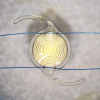Four-flanged polypropylene optic piercing technique for scleral fixation of multifocal intraocular lens
- PMID: 37752479
- PMCID: PMC10521417
- DOI: 10.1186/s12886-023-03133-7
Four-flanged polypropylene optic piercing technique for scleral fixation of multifocal intraocular lens
Abstract
Background: To evaluate the feasibility of creating flanges using an optic piercing technique with a 6 - 0 polypropylene monofilament for scleral fixation of dislocated one-piece diffractive multifocal intraocular lenses (IOLs).
Study design: Experimental study and case series.
Subjects: Optical bench test and eyes with IOL dislocation.
Methods: Two separate 6 - 0 polypropylenes were penetrated twice at the opposite peripheral optic of the TECNIS Synergy IOL (Johnson & Johnson Vision). The root mean square of the modulation transfer function (MTFRMS), at between + 1.00 and - 4.00 D of defocus, was measured in the TECNIS Synergy IOL both with and without optic piercing in the optical bench study. This case series included three eyes from two patients who underwent scleral-fixation of multifocal IOLs using the four-flanged polypropylene optic piercing technique. The postoperative corrected distance visual acuity (CDVA) at 4 m, the uncorrected near visual acuity (UNVA) at 40 cm, and IOL centration were evaluated.
Results: The optical bench test showed no differences in MTFRMS values measured in the TECNIS Synergy IOL, either with or without optic piercing at all defocuses. In all three case series, the postoperative CDVA at 4 m was 20/20 and UNVA at 40 cm was J1. Postoperative anterior segment photographs showed good centration of IOLs in all cases.
Conclusion: The four-flanged polypropylene optic piercing technique for multifocal IOL scleral fixation can provide excellent clinical outcomes and IOL stability after surgery without diminishing the performance of the multifocal IOLs.
Keywords: Flanged; Optic piercing; Scleral fixation.
© 2023. BioMed Central Ltd., part of Springer Nature.
Conflict of interest statement
The authors declare no competing interests.
Figures







Similar articles
-
Three-point flanged optic piercing intrascleral fixation of multifocal intraocular lenses.Indian J Ophthalmol. 2025 Mar 1;73(3):455-461. doi: 10.4103/IJO.IJO_1960_24. Epub 2025 Feb 26. Indian J Ophthalmol. 2025. PMID: 40007280 Free PMC article.
-
Scleral fixation of subluxated or dislocated multifocal and multifocal toric intraocular lenses.Graefes Arch Clin Exp Ophthalmol. 2022 Apr;260(4):1195-1203. doi: 10.1007/s00417-021-05498-1. Epub 2021 Nov 24. Graefes Arch Clin Exp Ophthalmol. 2022. PMID: 34817677
-
Modified double-flanged technique in the management of dislocated posterior intraocular lenses.Graefes Arch Clin Exp Ophthalmol. 2025 Jul;263(7):1925-1932. doi: 10.1007/s00417-025-06795-9. Epub 2025 Mar 12. Graefes Arch Clin Exp Ophthalmol. 2025. PMID: 40069473
-
[Sutureless scleral intraocular lens fixation: report of nine cases and literature review].J Fr Ophtalmol. 2013 Oct;36(8):658-68. doi: 10.1016/j.jfo.2012.09.009. Epub 2013 Jul 25. J Fr Ophtalmol. 2013. PMID: 23891322 Review. French.
-
Posterior capsulorhexis combined with optic buttonholing: an alternative to standard in-the-bag implantation of sharp-edged intraocular lenses? A critical analysis of 1000 consecutive cases.Graefes Arch Clin Exp Ophthalmol. 2008 Jun;246(6):787-801. doi: 10.1007/s00417-008-0779-6. Epub 2008 Apr 19. Graefes Arch Clin Exp Ophthalmol. 2008. PMID: 18425525 Free PMC article. Review.
Cited by
-
Three-point flanged optic piercing intrascleral fixation of multifocal intraocular lenses.Indian J Ophthalmol. 2025 Mar 1;73(3):455-461. doi: 10.4103/IJO.IJO_1960_24. Epub 2025 Feb 26. Indian J Ophthalmol. 2025. PMID: 40007280 Free PMC article.
-
Preliminary findings from a retrospective comparative study on a novel hydrophobic C-loop monofocal intraocular lens.Sci Rep. 2025 Apr 1;15(1):11081. doi: 10.1038/s41598-025-89547-3. Sci Rep. 2025. PMID: 40169656 Free PMC article.
-
Re-fixation Using the Belt Loop Technique for Postoperative Subluxation of a Multifocal Intraocular Lens After Retinal Detachment Surgery: A Case Report.Cureus. 2025 Feb 24;17(2):e79585. doi: 10.7759/cureus.79585. eCollection 2025 Feb. Cureus. 2025. PMID: 40161112 Free PMC article.
References
-
- Kim JW, Eom Y, Park W, Song JS, Jeong JW, Park SK, Kim HM. Comparison of visual outcomes after two types of mix-and-match implanted trifocal extended-depth-of-focus and trifocal intraocular lenses. Graefes Arch Clin Exp Ophthalmol 2022. - PubMed
MeSH terms
Substances
Grants and funding
- grant numbers 13-2020-007/SNUBH Research Fund
- grant numbers 13-2020-007/SNUBH Research Fund
- K210790/TRC Research Grant of the Korea University Medicine and Korea Institute of Science and Technology
- K1625491, K1722121, K1811051, K1913161, and K2010921/Korea University Ansan Hospital grant
- K1625491, K1722121, K1811051, K1913161, and K2010921/Korea University grant
- Project Number: 9991007583, KMDF_PR_20200901_0296/The Korea Medical Device Development Fund grant funded by the Korea government (the Ministry of Science and ICT, the Ministry of Trade, Industry and Energy, the Ministry of Health & Welfare, the Ministry of Food and Drug Safety)
- 2020002960007, NTIS-1485017544/Korea Environment Industry & Technology Institute (KEITI) through Technology Development Project for Safety Management of Household Chemical Products, funded by Korea Ministry of Environment (MOE)
- S3127902/The Technology Development Program (S3127902) funded by the Ministry of SMEs and Startups(MSS, Korea)
- NRF-2021R1F1A1062017/The National Research Foundation of Korea (NRF) grant funded by the Korea government (MSIT)
LinkOut - more resources
Full Text Sources
Miscellaneous

